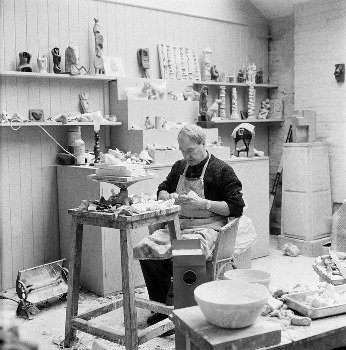Henry Moore
dal 8/2/2015 al 1/4/2015
Segnalato da
8/2/2015
Henry Moore
Gagosian Gallery 2, London
Wunderkammer - Origin of Forms. The exhibition, curated by Richard Calvocoressi, explores the origins and processes behind Moore's sculptures by recreating his maquette studio at Perry Green.

Curated by Richard Calvocoressi
Gagosian London is pleased to present “Henry Moore: Wunderkammer—Origin of Forms,” curated by Richard Calvocoressi, Director of The Henry Moore Foundation.
A giant of modern sculpture, Moore engaged the abstract, the surreal, the primitive and the classical in vigorous corporeal forms that are as accessible and familiar as they are avant-garde. His large-scale works celebrate the power of organic imagery at a time when traditional representation was largely eschewed by the vanguard art establishment. Their overwhelming physicality and forceful presence promotes a charged relation between sculpture, site, and viewer.
This special exhibition explores the origins and processes behind Moore’s sculptures by recreating his maquette studio at Perry Green—now home to The Henry Moore Foundation—at the Davies Street gallery. His Wunderkammer of natural stones, shells, bones, animal skulls, and other found objects will be presented alongside the drawings and sculptural maquettes that they inspired, demonstrating the metamorphosis from nature to sculpture, from inanimate object to human or animal form, that was the impetus of his oeuvre. Moore often cast natural specimens into plaster without further intervention as the first step of their absorption into his vast figurative idiom. Progressions can be traced between organic elements, preliminary sketches, maquettes and finished bronzes—for example, the amorphous totemic stack contoured in a 1955 maquette that is monumentalized in Upright Motive No. 5 (1955–56). These fluid evolutions also occur in reverse, as in the Studies after Crucifixion Sculpture (1954–56) executed in pencil and ink. These, and more than sixty works on paper, treat pebbles, trees, sheep, birds, Moore's own hands, and nude figures, demonstrating the sheer breadth of biomorphic subjects that find tenuous harmonies in visionary monumental sculpture.
In counterpoint to this intimate exhibition drawn from Moore's working processes, two monumental bronze sculptures Relief No. 1 (1959) and Upright Motive No. 9 (1979) will be installed in Berkeley Square, Mayfair, from February 9–May 29, 2015. Over two metres high, Relief No.1 (1959) grew out of the maquettes Moore made in 1955 for his brick Wall Relief, commissioned by the Bouwcentrum in Rotterdam. Four of these maquettes are included in the present exhibition. Moore wished to emphasise the forceful, projectional qualities of relief as opposed to using it pictorially, as in the narrative friezes of Renaissance sculpture. Thus the head and shoulders, torso, and legs of the figure are composed in three distinct parts, with the protruding umbilicus and receding chest exaggerated for expressive strength. The Upright Motives also have their origin in Moore's maquettes for the Bouwcentrum Wall Relief. They are among his most powerful and affecting monuments—part biomorph, part machine; among many other things, a fusion of totem pole and crucifix. Upright Motive No.9 (1979), based on a maquette of 1968, is the most figurative in the series, in which an architectural column appears to metamorphose into a female form.
The exhibition is accompanied by a fully illustrated catalogue with a new essay by Richard Calvocoressi, and his discussion about Moore's Wunderkammer with artist Edmund de Waal.
Image: Henry Moore, working on a plaster in the Maquette Studio, Perry Green, c. 1960. Photo by John Hedgecoe. Reproduced by permission of The Henry Moore Foundation
Press Contact:
Erica Bolton, erica.bolton@boltonquinn.com
Opening: Monday, February 9th, from 6:00 to 8:00pm
Gagosian Gallery
17-19 Davies Street
London W1K 3DE
Hours: Tue–Sat 10-6



